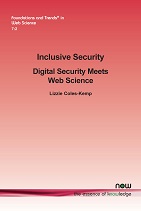Inclusive Security: Digital Security Meets Web Science
By Lizzie Coles-Kemp, Information Security Group, Royal Holloway University of London, UK, lizzie.coles-kemp@rhul.ac.uk
Abstract
The rationale for designing, implementing and managing security technologies has a notion of “risk” at its core; the risk of compromise to technology or information weighed up against the cost of protecting against such an incursion. However, such approaches have been focused on the protection of technology and information, with the assumption that if this is protected then people are also protected; an assumption that is much harder to maintain in a more open, networked context such as the one that has been enabled by growth of the World Wide Web. Grounded in the interdisciplinary endeavours that characterise Web Science, this monograph presents the case for a more inclusive form of technological security. Such a security places the security of technology in the context of the security of people operating in a web-enabled and digitally-connected society and results in a digital security that responds to the enmeshed nature of technology and society. This monograph uses a wide analytical lens that encompasses the sociotechnical infrastructures, networks of power and the practices that shape our interactions with and through digital technologies to explore this more expansive form of security.
Inclusive Security: Digital Security Meets Web Science
As we become increasingly dependent on digital products in all aspects of our lives, the reliability of that technology increases in importance. Technological security can be thought of as the control of access to technical systems and the control of the use of those systems. However, the way that digital technologies are woven across the fabric of our everyday lives, and are embedded in all our institutions, means that we need a paradigm for understanding technological security as being part of other forms of security.
This monograph introduces the paradigm of digital security that not only encompasses the protection of digital technologies and the data it produces but also the practices and processes that link those technologies. It encompasses the political and social processes and practices that shape the meanings and experiences of the digital protection mechanisms. In a digitally mediated society, security of the state, of society, of individuals, and of technologies are bound together through these processes and practices, giving new security meanings to security technologies and policies. Grounded in the interdisciplinary endeavours that characterise Web Science, this monograph presents the case for this more inclusive form of technological security. Such a security places the security of technology in the context of the security of people operating in a web-enabled and digitally-connected society and results in a digital security that responds to the enmeshed nature of technology and society.
This monograph situates digital security within the broader landscape of social and political theories of security, and uses a critical security lens to encourage the reader to explore how digitally networked technologies are both included in and influenced by the co-creation of artefacts and practices in open environments.
